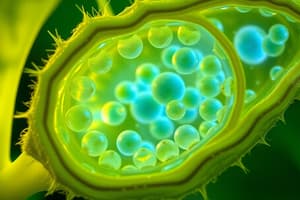Podcast
Questions and Answers
Where does the process of photosynthesis occur in plant cells?
Where does the process of photosynthesis occur in plant cells?
- Endoplasmic Reticulum
- Golgi Apparatus
- Chloroplasts (correct)
- Nucleus
What is the primary pigment responsible for the green color of plants?
What is the primary pigment responsible for the green color of plants?
- Chlorophyll (correct)
- Phycobilins
- Carotenoids
- Anthocyanins
Which part of the plant cell provides protection and support?
Which part of the plant cell provides protection and support?
- Nucleus
- Cytoplasm
- Cell Wall (correct)
- Cell Membrane
What is the main purpose of light-dependent reactions in photosynthesis?
What is the main purpose of light-dependent reactions in photosynthesis?
In which part of a plant cell does the regulation of material movement occur?
In which part of a plant cell does the regulation of material movement occur?
What is the primary function of chloroplasts in plant cells?
What is the primary function of chloroplasts in plant cells?
Which cells form the vascular system of plants for the transport of water and nutrients?
Which cells form the vascular system of plants for the transport of water and nutrients?
Which phase of plant growth involves the production of flowers and seeds?
Which phase of plant growth involves the production of flowers and seeds?
What is the main function of hormones such as auxins, gibberellins, and cytokinins in plants?
What is the main function of hormones such as auxins, gibberellins, and cytokinins in plants?
Why have some plants developed deep roots?
Why have some plants developed deep roots?
Flashcards are hidden until you start studying
Study Notes
Plant Structure and Function
Plants are diverse organisms that are important for various ecosystems, and understanding their structure and function is crucial for their conservation and sustainable utilization. In this article, we will discuss the subtopics of photosynthesis, cell structure in plants, transport in plants, plant growth and development, and plant adaptations to the environment.
Photosynthesis
Photosynthesis is the process by which plants convert light energy into chemical energy, which is stored in the form of glucose. This process occurs in the chloroplasts of plant cells, which are rich in chlorophyll, the pigment responsible for the green color of plants. Photosynthesis involves two main stages: the light-dependent reactions and the light-independent reactions. During the light-dependent reactions, light energy is absorbed by chlorophyll and used to generate ATP and NADPH, while during the light-independent reactions (Calvin cycle), carbon dioxide from the atmosphere is fixed into organic compounds, primarily glucose.
Cell Structure in Plants
Plant cells have a unique structure that allows them to carry out various functions. The cell wall provides protection and support, while the cell membrane regulates the movement of materials in and out of the cell. The cytoplasm is the jelly-like substance inside the cell, containing various organelles, such as the nucleus, mitochondria, and chloroplasts. The nucleus contains genetic material, while the mitochondria generate ATP through cellular respiration. Chloroplasts are responsible for photosynthesis.
Transport in Plants
Transport in plants involves the movement of water, nutrients, and other substances from one part of the plant to another. This is facilitated by specialized cells called xylem and phloem, which form the vascular system of plants. Xylem transports water and minerals from the roots to the leaves, while phloem transports sugars and other organic compounds from the leaves to other parts of the plant. This transport process is driven by the pressure of water in the xylem and the movement of substances against a concentration gradient.
Plant Growth and Development
Plant growth and development are influenced by various factors, including light, temperature, water, and nutrients. During the vegetative growth phase, plants grow leaves, stems, and roots, while during the reproductive growth phase, plants produce flowers and seeds. Plant growth and development are regulated by hormones, such as auxins, gibberellins, and cytokinins, which control cell division, elongation, and differentiation.
Plant Adaptations to the Environment
Plants have evolved various adaptations to survive and thrive in different environments. For example, some plants have developed deep roots to access water in dry conditions, while others have developed small leaves to reduce water loss through transpiration. Some plants have adapted to extreme temperatures by producing protective pigments or hairs, while others have developed specialized structures for pollination and seed dispersal.
In conclusion, understanding the structure and function of plants is essential for their conservation and sustainable utilization. By studying photosynthesis, cell structure, transport, growth and development, and adaptations to the environment, we can gain insights into the complex processes that enable plants to thrive in diverse ecosystems.
Studying That Suits You
Use AI to generate personalized quizzes and flashcards to suit your learning preferences.




